
Wine Culture and Information since 2002 - Volume 22
 Wine Culture and Information since 2002 - Volume 22 |
|
Issue 64, June 2008 |
Contents |
|
|
Lambrusco? Why not? |
|
The wines of Italy take advantage of a unique heritage, a heritage made of hundreds of autochthonous grapes which since many centuries color the vineyards of this country. Not always these indigenous grapes have been favored by the choices of producers. Despite many are trying since many years the revaluation of these varieties, there are still many producers who prefer using the grapes considered as international, mainly of French origin, who use both alone as well as blended with the grapes of their territories. It may also be a matter of “fashion” - or simply a commercial matter - but if we consider the wines currently produced in Italy, most of them make use of “international” grapes. It is very evident and it would make no use to deny this: names like Merlot, Chardonnay, Sauvignon Blanc and Cabernet Sauvignon - as to mention some of the most common ones - have a certain charm on consumers and on the psychology of senses, indeed, they frequently represent the winning point for a commercial success. Italian autochthonous grapes are therefore not suited for making commercial and interesting wines for consumers? Of course not. There are so many examples in Italy - from Vallée d'Aoste to Sicily - of excellent wines which can witness the excellence of Italian autochthonous grapes. However, among the many indigenous grapes of this country, there undoubtedly are positions of privilege, autochthonous grapes having a high reputation and fame, and others - and most of the times unjustly - destined to solely play the role of the ugly duckling, grapes suited for the production of “ordinary” wines only having little or no enological interest. This consideration is, of course, highly disputable. How many secondary grapes and of low enological interest have been transformed into real main actors thanks to the job of “visionary” wine makers and “stubborn” producers, by relying - first of all - to quality criteria and obtaining excellent results? Quality. A word which can make the difference in everything, including wine. It should be said - for the sake of truth - many autochthonous grapes, too much for sure, have been literally abused, not only with the purpose of making low quality products, but also for making huge quantities of wines: the more there is, the more can be sold. Because of this speculative behavior, many grapes have never been used for quality production, while favoring a denigratory culture towards these grapes, therefore making consumers believe “certain” grapes are only suited for making bad wine. Autochthonous Italian grapes which are unjustly considered “lesser”, both by consumers as well as wine making industries are many, unjustly condemned to the role of Cinderella with no hope to show their real value. Among the many grapes which could be mentioned as an example, one in particular is considered by many years a lesser grape and that recently - luckily - some producers are trying to revaluate: Lambrusco. We guess many of our readers, by reading the name “Lambrusco”, are thinking about very ordinary wine, sometimes exaggeratedly sparkling and with an evident sweet taste, something to be considered as a wine with no hope and which will never be able to show anything recalling quality and surprise. True, and it makes no sense to deny it: most of the wines produced with Lambrusco grapes do not certainly bring thoughts of quality of something capable of expressing quality. However it is also true generalization only brings the raising of prejudices and does not allow the understanding of things, most of the times keeps people away from the attempt of understanding things. If it is true most of Lambrusco wines do not certainly give this grape a dignity, it should also be said there are producers who have obtained excellent results, therefore showing Lambrusco can really make great things, just like any other grape. And when quality meets Lambrusco, the result is amazing and in a moment that not very representing ocean of Lambrusco is forgotten. Lambrusco - and with this we are considering all Lambrusco varieties - is not a lesser grape and it certainly deserves more than we usually find in bottles. Maybe the fact most of the Lambrusco is produced in the slightly sparkling style, does not help to revaluate this grape. In fact, if it is true bubbles are considered noble in sparkling wines - in particular in “classic method” wines - they become not noble at all when slightly sparkling wines are mentioned. This is also because of the “disputable” methods used for the production of low quality slightly sparkling wines; the fact Lambrusco is “frizzante” (Italian for “slightly sparkling”) does not help to make things better. Slightly sparkling, sweet or dry, Lambrusco - thanks to the job of some serious producers - is showing to be a grape capable of making good quality wines. Indeed, Lambrusco grape has everything in order to make a good wine, although the tradition of its land wants this wine to be always frizzante, that is slightly sparkling. Also etymology seems to connect, according to some theories, Lambrusco to bubbles. The name Lambrusco could in fact come from Latin Lab, meaning lip, and ruscus, that is something pungent to the palate, that is slightly sparkling. Another theory believes Lambrusco comes from Latin Labrum, that is margin, as it was a vine typically and wildly growing in the borders of fields - that is a wild variety - in the parts less used for cultivation. Lambrusco is mainly common in Emilia Romagna - in particular in the provinces of Modena and Reggio Emilia - and in Lombardy, in the province of Mantua. The most important varieties are Lambrusco di Sorbara, Lambrusco Grasparossa and Lambrusco Salamino, however the family is completed by Lambrusco Marani, Lambrusco Maestri, Lambrusco Montericco and Lambrusco Viadanese, as well as the less known varieties Lambrusca di Alessandria, Lambrusco a foglia frastagliata and the now extinguished Lambrusco Oliva. Each of these varieties, in their typical areas of cultivation, produces very interesting wines in case quality is the primary factor, unfortunately rare and adopted by few producers. Lambrusco is a grape - and a wine - which must certainly be understood and rediscovered, capable of giving fine emotions just like other famous and renowned wines. Lambrusco? Certainly yes! Producers and wine makers, it is your turn: give Lambrusco the dignity it deserves!
|
||||
Comparing Vino Nobile di MontepulcianoAmong the greatest wines of Italian enology, Vino Nobile di Montepulciano is mainly produced with Prugnolo Gentile grape, better known as Sangiovese Grosso |
|
Vino Nobile di Montepulciano is among the most ancient known wines of Italy or, better to say, one of those wines which were in the past already associated to their territories and that still today are used to identify them. Produced in the city of Montepulciano - in the province of Siena - it has nothing in common with the homonymous red berried grape found in other Italian regions and in particular Abruzzo, Vino Nobile is mainly obtained with Prugnolo Gentile, the name used in Montepulciano to call Sangiovese Grosso. Prugnolo Gentile - despite it is the main grape of this wine, frequently used alone - it is not the only grape used for the production of Vino Nobile di Montepulciano, to which it is sometimes added Canaiolo Nero, Colorino and Mammolo. According to the production disciplinary, Vino Nobile di Montepulciano must age for at least 24 months, of which most of them in cask or barrique, 36 months for the riserva style. Montepulciano's wine is mentioned for the first time in 789 AD, in a document written by clergyman Arnipert with which he donated a vineyard of the castle of Policiano to the church of San Silvestro at Lanciniano sull'Amiata. From that moment on, the wine of Montepulciano will be mentioned in other documents, but it will be in 1549 this wine is mentioned with words of praise. In that year Sante Lancerio - cellar master and wine steward of Pope Paul III - defined it as truly perfect wine, a gentleman's wine. The wine of Montepulciano, in the course of the years, received the title of “King”, in the dithyramb “Bacchus in Tuscany”, written in 1685 by Francesco Redi - doctor, naturalist and literate from Arezzo - where in the final verse can be read “Montepulciano is the King of all wines”. The adjective nobile - that is, noble - is found for the first time in 1787, where in an accounting report of the Governor of “Regio Ritiro di San Girolamo” - Giovan Filippo Neri - the wine is mentioned with the term nobile.
|
|
The main protagonist of Vino Nobile di Montepulciano is Prugnolo Gentile, name with which in this area is called Sangiovese Grosso. Despite in the production of this wine are allowed other grapes as well - in particular Canaiolo Nero, Mammolo and Colorino - Vino Nobile di Montepulciano is frequently produced with Prugnolo Gentile only. Of good vigor, characterized by clusters rich in round berries of a blue-black skin and rich in bloom, Prugnolo Gentile usually reaches full ripening between the end of September and the first days of October. Prugnolo Gentile has a pretty high content in sugar - therefore producing wines with a pretty high alcohol by volume - and also the content in acids is pretty high, a quality giving an evident crispness in its wines. The content in polyphenols - to which are also added to ones passed from wood during aging - as well as acidity and alcohol, allow the wines produced with this grape to stand to long periods of aging and to pretty long evolution times, frequently more than 20 years.
The wines selected for our comparative tasting are all produced with 100% Prugnolo Gentile, and they differ for the type of container and the period used for aging. The goal of this comparative tasting is the understanding of Prugnolo Gentile's qualities in function of the aging technique. The first wine of our comparative tasting is Dei's Vino Nobile di Montepulciano Riserva Bossona, aged for 24 months in cask and for 12 in bottle. The second wine is Tenuta Valdipiatta's Vino Nobile di Montepulciano Vigna d'Alfiero, aged for 18 months in barrique and for 12 in bottle. The third wine is Poliziano's Vino Nobile di Montepulciano Asinone, for which has been used an aging technique of 18 months in cask and barrique, as well as 8 months of aging in bottle. The wines will be served at the temperature of 18° C (65° F) and will be used - as usual - three ISO tasting glasses.
|
||||||||
|
Prugnolo Gentile - just like all the other Sangiovese varieties - is characterized by a coloring capacity which can be defined as “average”. Wines produced with this grape show in fact a moderate transparency, something different from what can be observed, for example, in wines produced with Cabernet Sauvignon. There are however cases in which the transparency of Prugnolo Gentile is pretty low, a quality which can be obtained with the concentration of coloring substances found in grapes, by keeping - for example - a low yield in vineyards. Because of the long time of aging before being commercialized, the color which can be observed in “young” Vino Nobile di Montepulciano is generally intense and brilliant ruby red, with nuances of the same color. As time goes by, the color tends to get intense garnet red hues and evident brick red nuances. We will begin the appearance analysis from Dei's Vino Nobile di Montepulciano Riserva Bossona. By holding the glass tilted on a white surface - a white sheet of paper or a white tablecloth will do - we will evaluate, at the base of the glass where the liquid mass is thicker, the color. It will be observed an intense ruby red color, with a moderate transparency. By observing the wine to the edge of the liquid mass, that is towards the opening of the glass, we will notice evident garnet red nuances. Let's now pass to the evaluation of the second wine of our comparative tasting: Tenuta Valdipiatta's Vino Nobile di Montepulciano Vigna d'Alfiero. The color of this wine, observed while holding the glass tilted, is intense and brilliant ruby red, with garnet red nuances, not so different from the previous wine. As opposed to the previous wine, here transparency is lower. The color of the third wine - Poliziano's Vino Nobile di Montepulciano Asinone - is not different from the previous ones: it can be in fact observed an intense ruby red color, whereas as opposed as the two previous wines, nuances are characterized by a ruby red. Also in this wine, just like in the previous one, it can be observed a low transparency.
|
|
Vino Nobile di Montepulciano is generally characterized by a pretty complex and interesting olfactory profile. This quality is given both by Prugnolo Gentile as well as the long aging times provided for the production disciplinary and which gives the wine an evident complex character. Despite its complexity, in Vino Nobile di Montepulciano are perceived more usual aromatic qualities as well, belonging to the world of flowers and fruit. Plum and black cherry are the main aromatic qualities belonging to the world of fruit and which can be perceived in Prugnolo Gentile, however it is not rare to find blueberry as well. The main representative of the world of flowers is violet, sometimes the rose as well. Vino Nobile di Montepulciano has complex aromatic qualities, such as vanilla, cinnamon, licorice, mace, nutmeg, tobacco, black pepper and pink pepper, as well as balsamic aromas of menthol and eucalyptus. We will begin the evaluation of aromas from Dei's Vino Nobile di Montepulciano Riserva Bossona. By holding the glass in vertical position and without swirling, we will do a first smell in order to evaluate opening aromas of the wine, made of “light” aromatic substances and which do not require a big quantity of oxygen in order to volatilize. From the glass will be appreciated intense and very clean aromas of plum, black cherry and violet: an opening which can be defined as typical and characteristic of Prugnolo Gentile and Vino Nobile di Montepulciano. Let's now proceed with the swirling of the glass in order to favor the oxygenation of the wine therefore allowing the volatilization of “heavy” aromas and which will complete the aromatic profile of the wine. From the glass will be perceived aromas of blueberry, raspberry and rose as well as more complex qualities of tobacco, vanilla, chocolate, cinnamon, pink pepper and mace. It should also be noticed the pleasing balsamic sensation of menthol, very pleasing and very balanced. The opening of the second wine - Tenuta Valdipiatta's Vino Nobile di Montepulciano Vigna d'Alfiero - is not very different from the previous wine: also in this case are perceived intense and very clean aromas of black cherry, plum and violet to which is added a pleasing aroma of blackberry. Let's now proceed with the swirling of the glass in order to favor the development of other aromas. From the glass will be perceived aromas of raspberry, blueberry and rose, as well as aromas of tobacco, vanilla, licorice, chocolate, cinnamon and mace, to which is added the balsamic touch of menthol. The opening of the third wine - Poliziano's Vino Nobile di Montepulciano Asinone - is characterized by intense and clean aromas of black cherry, plum, blueberry and violet, also in this case, a typical opening of Prugnolo Gentile. The aromatic profile of this wine - evaluated after having swirled the glass - is completed by intense and clean aromas of black currant, vanilla, cocoa, tobacco, licorice, pink pepper and hints of rubber. It should also be noticed the pleasing balsamic touch of menthol and the mineral hints of graphite.
|
||||
|
Thanks to the characteristics of Prugnolo Gentile, to the technique and the long time of aging, Vino Nobile di Montepulciano is pretty interesting to the taste. Among the main gustatory qualities are found an appreciable and refreshing acidity, an evident full structure, also given by the aging in cask or barrique. These qualities will be perceptible in Vino Nobile di Montepulciano since the moment of attack - that is the sensation perceived in the mouth at the first sip - where the pleasing acidity of Prugnolo Gentile and the astringency of tannins are opposed to the roundness given by aging and alcohol. Alcohol also plays an important role in balancing acidity and astringency: in Vino Nobile di Montepulciano it can in fact reach 15%, however the average volume is 14%. Also the structure perceived in the mouth is remarkable: evidently full and robust. Let's now proceed with the practical phase of tasting by beginning from Dei's Vino Nobile di Montepulciano Riserva Bossona. In the attack of this first wine is perceived the astringency produced by tannins as well as the typical acidity of Prugnolo Gentile, to which is added a sensation of robust structure. It should be noticed the role of alcohol and how it balances the wine. Also excellent is the correspondence to the nose. Let's now pass to the second wine: Tenuta Valdipiatta's Vino Nobile di Montepulciano Vigna d'Alfiero. Also the attack of this wine is pretty astringent and with a robust structure, however, as opposed to the previous wine, crispness is slightly lower with a “rounder” sensation. Also in this case it can be perceived the role played by alcohol in the balance. The attack of the third wine - Poliziano's Vino Nobile di Montepulciano Asinone - is tannic and robust, with an appreciable crispness and a pleasing roundness, very well balanced by alcohol.
|
|
Another interesting quality of Vino Nobile di Montepulciano is represented by the final sensations which can be perceived in the mouth after having swallowed the wine, generally characterized by a long taste-olfactory persistence. The finish of Dei's Vino Nobile di Montepulciano Riserva Bossona is persistent, leaving in the mouth pleasing and intense flavors of black cherry, plum and blueberry, typical in Prugnolo Gentile. The finish of Tenuta Valdipiatta's Vino Nobile di Montepulciano Vigna d'Alfiero is very persistent, leaving in the mouth long and intense flavors of plum, black cherry and blackberry. Also the finish of the third wine - Poliziano's Vino Nobile di Montepulciano Asinone - is characterized by a long persistence, leaving in the mouth long, intense and pleasing flavors of black cherry, blueberry and plum, very correspondent and typical in Prugnolo Gentile. It should be noticed the sensation of crispness and structure which can be perceived in the mouth after the swallowing of the three wines and the excellent correspondence to the nose.
|
Wines of the Month |
|
|
|
Score legend Prices are to be considered as indicative. Prices may vary according to the country or the shop where wines are bought |
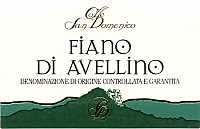
|
|
Fiano di Avellino 2007 |
|
| Colle di San Domenico (Campania, Italy) | |
| Grapes: Fiano | |
| Price: € 10.20 | Score: |
| This wine shows a brilliant straw yellow color and nuances of greenish yellow, very transparent. The nose denotes intense, clean, pleasing and refined aromas which start with hints of apple, medlar and plum followed by aromas of pineapple, hawthorn, broom and peach. The mouth has good correspondence to the nose, a crisp attack and however balanced by alcohol, good body, intense flavors. The finish is persistent with flavors of apple, plum and medlar. This Fiano di Avellino ages in steel tanks and ages for at least 2 months in bottle. | |
| Food Match: Pasta and risotto with crustaceans and fish, Broiled crustaceans, Sauteed white meat | |
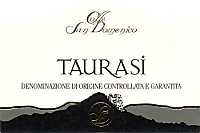
|
|
Taurasi 2003 |
|
| Colle di San Domenico (Campania, Italy) | |
| Grapes: Aglianico | |
| Price: € 15.70 | Score: |
| This Taurasi shows a brilliant ruby red color and nuances of garnet red, little transparency. The nose denotes intense, clean, pleasing and refined aromas which start with hints of black cherry, plum and blackberry followed by aromas of violet, vanilla, tobacco, pink pepper, cinnamon and menthol. The mouth has good correspondence to the nose, a tannic attack and however balanced by alcohol, full body, intense flavors. The finish is persistent with flavors of black cherry, plum and blackberry. This Taurasi ages for 24 months in barrique followed by at least 6 months of aging in bottle. | |
| Food Match: Roasted meat, Braised and stewed meat, Hard cheese | |
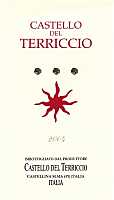
|
|
Castello del Terriccio 2004 |
|
| Castello del Terriccio (Tuscany, Italy) | |
| Grapes: Syrah (50%), Petit Verdot (25%), Other Red Grapes (25%) | |
| Price: € 60.00 | Score: |
| Castello del Terriccio shows an intense ruby red color and nuances of ruby red, little transparency. The nose denotes intense, clean, pleasing, refined and elegant aromas which start with hints of black cherry, plum and black currant followed by aromas of blueberry, violet, vanilla, tobacco, licorice, black pepper, cocoa, cinnamon, eucalyptus, mace and leather. The mouth has excellent correspondence to the nose, a tannic attack and however balanced by alcohol, full body, intense flavors, agreeable. The finish is very persistent with long flavors of black cherry, plum and black currant. Castello del Terriccio ages for 18 months in barrique. | |
| Food Match: Game, Roasted meat, Braised and stewed meat with mushrooms, Hard cheese | |
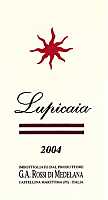
|
|
Lupicaia 2004 |
|
| Castello del Terriccio (Tuscany, Italy) | |
| Grapes: Cabernet Sauvignon (85%), Merlot (10%), Petit Verdot (5%) | |
| Price: € 100.00 | Score: |
| Lupicaia shows an intense ruby red color and nuances of ruby red, little transparency. The nose reveals intense, clean, pleasing, refined and elegant aromas which start with hints of black cherry, plum and black currant followed by aromas of blueberry, violet, vanilla, tobacco, licorice, cocoa, leather, mace and eucalyptus. The mouth has excellent correspondence to the nose, a tannic attack and however balanced by alcohol, full body, intense flavors, agreeable. The finish is very persistent with long flavors of black cherry, plum and black currant. Lupicaia ages for 18 months in barrique. | |
| Food Match: Game, Roasted meat, Stewed and braised meat, Hard cheese | |
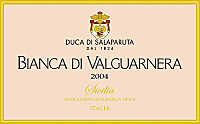
|
|
Bianca di Valguarnera 2004 |
|
| Duca di Salaparuta (Sicily, Italy) | |
| Grapes: Inzolia | |
| Price: € 20.50 | Score: |
| Bianca di Valguarnera shows a brilliant golden yellow color and nuances of straw yellow, very transparent. The nose denotes intense, clean, pleasing and refined aromas which start with hints of plum, apple and almond followed by aromas of citrus fruits, peach, anise, hawthorn, praline, vanilla and pine. The mouth has good correspondence to the nose, a crisp attack and pleasing roundness, however balanced by alcohol, good body, intense flavors. The finish is persistent with flavors of apple, peach and almond. Bianca di Valguarnera ages in barrique for at least 8 months followed by 12 months of aging in bottle. | |
| Food Match: Stuffed pasta with mushrooms, Roasted fish, Roasted white meat | |
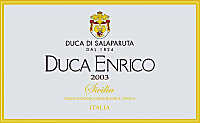
|
|
Duca Enrico 2003 |
|
| Duca di Salaparuta (Sicily, Italy) | |
| Grapes: Nero d'Avola | |
| Price: € 35.00 | Score: |
| Duca Enrico shows an intense ruby red color and nuances of garnet red, little transparency. The nose denotes intense, clean, pleasing, refined and elegant aromas that start with hints of black cherry, plum and blackberry followed by aromas of blueberry, violet, vanilla, tobacco, chocolate, cinnamon, pink pepper and menthol. The mouth has good correspondence to the nose, a tannic attack and however balanced by alcohol, full body, intense flavors, agreeable. The finish is persistent with flavors of black cherry, plum and blackberry. A well made wine. Duca Enrico ages for 18 months in barrique followed by 12 months of aging in bottle. | |
| Food Match: Game, Roasted meat, Braised and stewed meat, Hard cheese | |
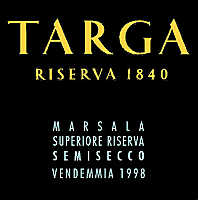
|
|
Marsala Superiore Riserva Targa Riserva 1840 1998 |
|
| Florio (Sicily, Italy) | |
| Grapes: Grillo | |
| Price: € 11.00 - 50cl | Score: |
| Marsala Superiore Riserva Targa Riserva 1840 shows a deep amber yellow color and nuances of amber yellow, transparent. The nose reveals intense, clean, pleasing and refined aromas which start with hints of dried fig, caramel and almond followed by aromas of date, honey, rancho, vanilla, apricot jam, leather, licorice and orange marmalade. The mouth has good correspondence to the nose, an alcoholic and sweet attack, however balanced, full body, intense flavors, pleasing roundness. The finish is persistent with flavors of dried fig, almond and caramel. Marsala Superiore Riserva Targa Riserva 1840 ages for at least 6 years in cask followed by at least 6 months of aging in bottle. | |
| Food Match: Confectionery, Almond tarts, Hard and piquant cheese | |
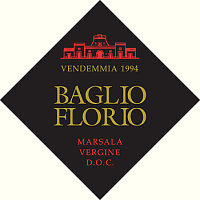
|
|
Marsala Vergine Baglio Florio 1994 |
|
| Florio (Sicily, Italy) | |
| Grapes: Grillo | |
| Price: € 21.50 - 50cl | Score: |
| Marsala Vergine Baglio Florio shows a brilliant amber yellow color and nuances of amber yellow, transparent. The nose reveals intense, clean, pleasing, refined and elegant aromas which start with hints of rancho, dried fig and almond followed by aromas of date, honey, citrus fruit peel, raisin, vanilla, nail polish, date, walnut husk and licorice. The mouth has excellent correspondence to the nose, an alcoholic and round attack, however balanced, full body, intense flavors, agreeable. The finish is very persistent with long flavors of dried fig, almond and honey. A well made wine. Marsala Vergine Baglio Florio ages for more than 10 years in cask followed by at least 1 year of aging in bottle. | |
| Food Match: Smoked fish, Roasted meat, Hard cheese | |
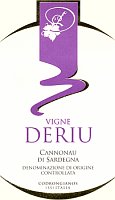
|
|
Cannonau di Sardegna 2006 |
|
| Vigne Deriu (Sardinia, Italy) | |
| Grapes: Cannonau | |
| Price: € 8.60 | Score: |
| This Cannonau di Sardegna shows an intense ruby red color and nuances of garnet red, moderate transparency. The nose denotes intense, clean and pleasing aromas that start with hints of black cherry, plum and blueberry followed by aromas of violet, carob and vanilla. The mouth has good correspondence to the nose, a slightly tannic attack and however balanced by alcohol, good body, intense flavors. The finish is persistent with flavors of black cherry and plum. | |
| Food Match: Stuffed pasta with meat, Broiled meat and barbecue, Stewed meat | |
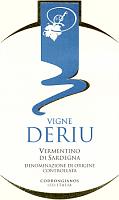
|
|
Vermentino di Sardegna 2007 |
|
| Vigne Deriu (Sardinia, Italy) | |
| Grapes: Vermentino | |
| Price: € 8.60 | Score: |
| This Vermentino di Sardegna shows an intense greenish yellow color and nuances of greenish yellow, very transparent. The nose reveals intense, clean, pleasing and refined aromas that start with hints of pear, peach and apple followed by aromas of pineapple, broom, nettle and hawthorn. The mouth has good correspondence to the nose, a crisp attack and however balanced by alcohol, good body, intense flavors, agreeable. The finish is persistent with flavors of pear, peach and pineapple. This wine ages in steel tanks. | |
| Food Match: Pasta and risotto with crustaceans, Mushroom soups, Stewed fish | |
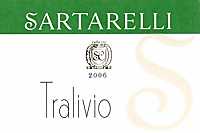
|
|
Verdicchio dei Castelli di Jesi Classico Superiore Tralivio 2006 |
|
| Sartarelli (Marches, Italy) | |
| Grapes: Verdicchio | |
| Price: € 11.00 | Score: |
| Verdicchio dei Castelli di Jesi Classico Superiore Tralivio shows a brilliant straw yellow color and nuances of greenish yellow, very transparent. The nose reveals intense, clean, pleasing and refined aromas which start with hints of apple, peach and plum followed by aromas of pineapple, almond, medlar, pear, broom, hawthorn and hints of mineral. The mouth has good correspondence to the nose, a crisp attack and however balanced by alcohol, good body, intense flavors, agreeable. The finish is persistent with flavors of apple, plum and almond. This wine ages for 6 months in steel tanks followed by 4 months of aging in bottle. | |
| Food Match: Broiled fish, Roasted white meat, Fish soups, Fried fish | |
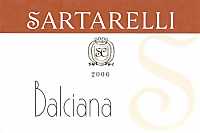
|
|
Verdicchio dei Castelli di Jesi Classico Superiore Balciana 2006 |
|
| Sartarelli (Marches, Italy) | |
| Grapes: Verdicchio | |
| Price: € 26.00 | Score: |
| Verdicchio dei Castelli di Jesi Classico Superiore Balciana shows an intense golden yellow color and nuances of golden yellow, very transparent. The nose reveals intense, clean, pleasing, refined and elegant aromas which start with hints of honey, ripe apricot and almond followed by aromas of quince, cooked pear, peach, hazelnut, plum, hawthorn, broom, chamomile and pineapple. The mouth has excellent correspondence to the nose, a crisp attack and pleasing roundness, however balanced by alcohol, full body, intense flavors, agreeable. The finish is very persistent with long flavors of apricot, quince and almond. A well made wine. Verdicchio dei Castelli di Jesi Classico Superiore Balciana ages for 8 months in steel tanks followed by 6 months of aging in bottle. | |
| Food Match: Stuffed pasta with mushrooms, Roasted fish, Roasted white meat, Hard cheese | |
News |
|
In this section are published news and information about events concerning the world of wine and food. Whoever is interested in publishing this kind of information can send us a mail to our address.
|
Wine Parade |
|
|
| The best 15 wines according to DiWineTaste's readers. To express your best three wines send us an E-mail or fill in the form available at our WEB site. |
| Rank | Wine, Producer | |
|---|---|---|
| 1 |
| Bradisismo 2003, Inama (Italy) |
| 2 |
| San Leonardo 2001, Tenuta San Leonardo (Italy) |
| 3 |
| Barolo Bussia 2001, Prunotto (Italy) |
| 4 |
| Wine Obsession 2001, Vignamaggio (Italy) |
| 5 |
| Collio Bianco Col Disôre 2004, Russiz Superiore (Italy) |
| 6 |
| Barolo Cannubi Boschis 2001, Sandrone (Italy) |
| 7 |
| Chianti Classico Riserva Novecento 2000, Dievole (Italy) |
| 8 |
| Blanc des Rosis 2006, Schiopetto (Italy) |
| 9 |
| Amarone della Valpolicella Classico 2000, Zenato (Italy) |
| 10 |
| Sforzato di Valtellina San Domenico 2002, Triacca (Italy) |
| 11 |
| Sforzato di Valtellina Canua 2001, Conti Sertoli Salis (Italy) |
| 12 |
| Aglianico del Vulture La Firma 2004, Cantine del Notaio (Italy) |
| 13 |
| Sangiovese di Romagna Superiore Riserva Thea 2005, Tre Monti (Italy) |
| 14 |
| Soave Classico Monte Alto 2004, Ca' Rugate (Italy) |
| 15 |
| Sagrantino di Montefalco Collepiano 2003, Arnaldo Caprai (Italy) |
| |||||||
Privacy Policy | |||||||


| Copyright © 2002-2024 Antonello Biancalana, DiWineTaste - All rights reserved |
| All rights reserved under international copyright conventions. No part of this publication and of this WEB site may be
reproduced or utilized in any form or by any means, electronic or mechanical, without permission in writing from DiWineTaste. |